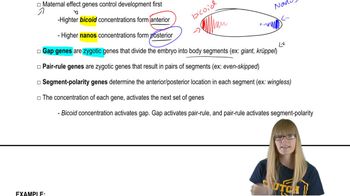Table of contents
- 1. Introduction to Genetics51m
- 2. Mendel's Laws of Inheritance3h 37m
- 3. Extensions to Mendelian Inheritance2h 41m
- 4. Genetic Mapping and Linkage2h 28m
- 5. Genetics of Bacteria and Viruses1h 21m
- 6. Chromosomal Variation1h 48m
- 7. DNA and Chromosome Structure56m
- 8. DNA Replication1h 10m
- 9. Mitosis and Meiosis1h 34m
- 10. Transcription1h 0m
- 11. Translation58m
- 12. Gene Regulation in Prokaryotes1h 19m
- 13. Gene Regulation in Eukaryotes44m
- 14. Genetic Control of Development44m
- 15. Genomes and Genomics1h 50m
- 16. Transposable Elements47m
- 17. Mutation, Repair, and Recombination1h 6m
- 18. Molecular Genetic Tools19m
- 19. Cancer Genetics29m
- 20. Quantitative Genetics1h 26m
- 21. Population Genetics50m
- 22. Evolutionary Genetics29m
17. Mutation, Repair, and Recombination
Types of Mutations
Problem 2c
Textbook Question
Textbook QuestionGo online to the Online Mendelian Inheritance of Man (OMIM) website. Look up the following genetic conditions and answer the questions posed about them.
Go to the 'Population Genetics' section discussing the TSD gene. In a few sentences, summarize the human population in which TSD is most frequently found and give the approximate frequency of heterozygous carriers for the TSD mutation in North American Jews.
 Verified Solution
Verified SolutionThis video solution was recommended by our tutors as helpful for the problem above
Video duration:
1mPlay a video:
Was this helpful?
Key Concepts
Here are the essential concepts you must grasp in order to answer the question correctly.
TSD Gene and Its Role
The TSD gene, or Tay-Sachs disease gene, is responsible for producing an enzyme called hexosaminidase A, which is crucial for breaking down certain lipids in the brain. Mutations in this gene lead to the accumulation of GM2 gangliosides, causing severe neurological damage. Understanding the function of the TSD gene is essential for grasping the implications of its mutations and the resulting genetic conditions.
Recommended video:
Guided course

Segmentation Genes
Population Genetics
Population genetics is the study of genetic variation within populations and involves the examination of allele frequency distributions and changes over time. It helps in understanding how genetic traits, such as the TSD mutation, are passed through generations and how they affect specific populations, particularly in terms of carrier frequency and disease prevalence.
Recommended video:
Guided course

Descriptive Genetics
Carrier Frequency
Carrier frequency refers to the proportion of individuals in a population who carry one copy of a mutated gene but do not exhibit symptoms of the associated genetic disorder. In the context of TSD, the carrier frequency among North American Jews is notably high due to historical genetic drift and founder effects, making it a critical factor in assessing the risk of Tay-Sachs disease in this population.
Recommended video:
Guided course

New Alleles and Migration

 9:49m
9:49mWatch next
Master Point Mutations with a bite sized video explanation from Kylia Goodner
Start learning



